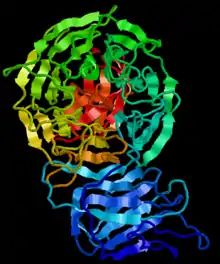Motif Kelch
Le motif Kelch, de l'allemand Kelch signifiant « calice », également écrit kelch, est un motif structurel largement distribué dans des protéines d'espèces allant des bactéries aux eucaryotes[2]. Il correspond à une séquence d'une cinquantaine de résidus d'acides aminés formant une « lame » en feuillet β à quatre brins. On en trouve de cinq à huit copies par protéine, qui se replient ensemble pour former un grand domaine en solénoïde de type β-propeller.

| Pfam | PF01344 |
|---|---|
| InterPro | IPR006652 |
| SMART | Kelch |
| SCOP | 1gof |
| SUPERFAMILY | 1gof |
| Famille OPM | 384 |
| Protéine OPM | 3ii7 |
| Pfam | PF07646 |
|---|---|
| Clan Pfam | CL0186 |
| InterPro | IPR011498 |
| SCOP | 1gof |
| SUPERFAMILY | 1gof |
| Pfam | PF13854 |
|---|---|
| Clan Pfam | CL0186 |
| Pfam | PF13964 |
|---|---|
| Clan Pfam | CL0186 |
Le motif Kelch est largement présent chez les bactéries et les eucaryotes. Le génome humain contient une centaine de protéines qui présentent un motif Kelch. Ce motif apparaît plusieurs fois par molécule de protéine[3]. On le trouve par exemple dans la protéine MIPP (en) de souris, chez plusieurs Poxviridae[4], dans les scruines α et β[5],[6], dans la galactose oxydase (en) de Dactylium dendroides[1], ainsi que dans la protéine YjhT d’Escherichia coli, une enzyme catalysant la mutarotation de l'acide sialique[7].
Dans le cas de la galatose oxydase, la répétition des motifs Kelch correspond à un feuillet β à quatre brins antiparallèles formant un β-propeller[8].
Notes et références
- (en) Nobutoshi Ito, Simon E. V. Phillips, Conrad Stevens, Zumrut B. Ogel, Michael J. McPherson, Jeffery N. Keen, Kapil D. S. Yadav et Peter F. Knowles, « Novel thioether bond revealed by a 1.7 Å crystal structure of galactose oxidase », Nature, vol. 350, no 6313, , p. 87-90 (PMID 2002850, DOI 10.1038/350087a0, Bibcode 1991Natur.350...87I, lire en ligne)
- (en) Josephine Adams, Reed Kelso et Lynn Cooley, « The kelch repeat superfamily of proteins: propellers of cell function », Trends in Cell Biologie, vol. 10, no 1, , p. 17-24 (PMID 10603472, DOI 10.1016/S0962-8924(99)01673-6, lire en ligne)
- (en) Feiyu Xue et Lynn Cooley, « Kelch encodes a component of intercellular bridges in Drosophila egg chambers », Cell, vol. 72, no 5, , p. 681-693 (PMID 8453663, DOI 10.1016/0092-8674(93)90397-9, lire en ligne)
- (en) Peer Bork, « Drosophila kelch motif is derived from a common enzyme fold », Journal of Molecular Biology, vol. 236, no 5, , p. 1277-1282 (PMID 8126718, DOI 10.1016/0022-2836(94)90056-6, lire en ligne)
- (en) M. Way, M. Sanders, M. Chafel, Y.H. Tu, A. Knight et P. Matsudaira, « beta-Scruin, a homologue of the actin crosslinking protein scruin, is localized to the acrosomal vesicle of Limulus sperm », Journal of Cell Science, vol. 108, no 10, , p. 3155-3162 (PMID 7593276, lire en ligne)
- (en) M. Way, M. Sanders, C. Garcia, J. Sakai et P. Matsudaira, « Sequence and domain organization of scruin, an actin-cross-linking protein in the acrosomal process of Limulus sperm », The Journal of Cell Biology, vol. 128, nos 1-2, , p. 51-60 (PMID 7822422, PMCID 2120335, DOI 10.1083/jcb.128.1.51, lire en ligne)
- (en) Emmanuele Severi, Axel Müller, Jennifer R. Potts, Andrew Leech, David Williamson, Keith S. Wilson et Gavin H. Thomas, « Sialic Acid Mutarotation Is Catalyzed by the Escherichia coli β-Propeller Protein YjhT », Journal of Biological Chemistry, vol. 283, no 8, , p. 4841-4849 (PMID 18063573, DOI 10.1074/jbc.M707822200, lire en ligne)
- (en) Nobutoshi Ito, Simon E.V. Phillips, Kapil D.S. Yadav et Peter F. Knowles, « Crystal structure of a free radical enzyme, galactose oxidase », Journal of Molecular Biology, vol. 238, no 5, , p. 794-814 (PMID 8182749, DOI 10.1006/jmbi.1994.1335, lire en ligne)
- Portail de la biochimie
- Portail de la biologie cellulaire et moléculaire